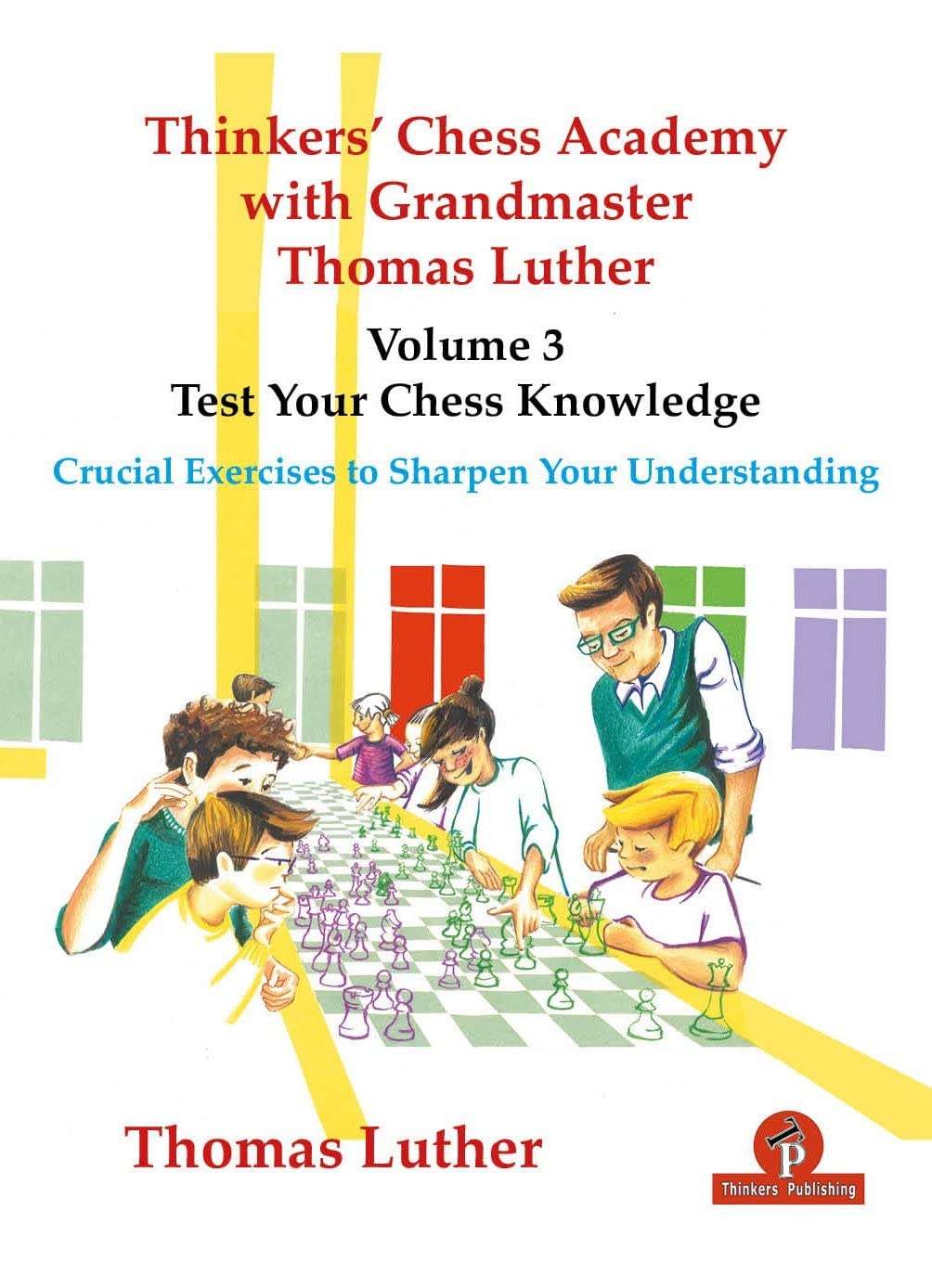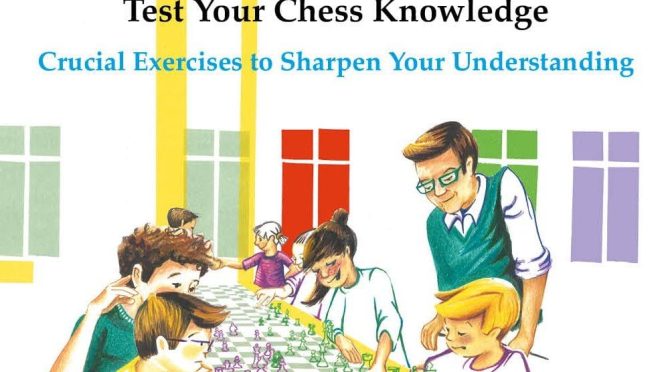Grandmaster Thomas Luther, born in 1969, is the first player with a disability to have entered the FIDE Top 100 rating list. In 2001 he was ranked 80th in the world. He has won the German Championship three times and is well known as an experienced and successful coach. In 2014 his achievements were recognised by being granted the title of FIDE Senior Trainer. In his career to-date he has published several books and DVDs. This is his fourth book for Thinkers’ Publishing, after a co-production with Jugend Schach Verlag entitled ‘Chess Coaching for Kids – the U10 Project‘ and the current series

This is the third volume in Thinkers’ Chess Academy (TCA), an ever-growing series written by Grandmaster and FIDE Senior Trainer Thomas Luther intended for beginners through to club standard players.
John Upham has previously reviewed the first volume, First Steps in Tactics, although I note a negative review on Amazon which considered the examples were too hard for the target market. Volume 2, From Tactics to Strategy – Winning Knowledge, which, I believe, hasn’t been submitted for review by BCN, covers more advanced tactics along with an introduction to strategy.
Volume 3 is designed as a workbook for readers of the two previous volumes, while also providing more challenging exercises for ambitious students.
From the author’s introduction (it’s also on the publisher’s website):
Not every reader is ambitious enough or has enough time to work very hard on his chess. That’s quite understandable and nothing to be ashamed of. You can enjoy chess very well without being a strong tournament player. You could just entertain yourself by playing through interesting combinations. In this case don’t try too hard to solve the Advanced Lessons or Master Class exercises. Have a look to make yourself familiar with the position, than look at the solution and enjoy the surprising combinations. You won’t learn as much as you would by racking your brain to crack the hard nuts. But some knowledge and experience will certainly rub off and increase your understanding of chess. I hope this book will help you to work towards your goals and let have you fun with chess.
The book has an unusual structure. We have 20 chapters alternately easier and harder, with the answers at the end of each chapter. Less experienced players are advised to work through the odd numbered chapters first before tackling the odd numbered chapters, while stronger players could work through the book in order, using the odd numbered chapters as ward-up exercises.
An interesting concept, but does it work? Let’s take a look inside. All the odd numbered chapters are billed simply as ‘Quick Test’, although their specific themes are discussed in the chapter introductions. The first Quick Test, which corresponds to Chapter 7 of TCA1, features mates in up to 2 moves. Other tests involve winning material in various ways. There is a gradual increase in length and complexity, until, by Chapter 19 you’ll be able to find wins (material or mate) in up to 5 moves.
I enjoyed Chapter 9 (Quick Test 5): From The Good Old Times!
Can you find this mate in 3 (Napier – Amateur 1904)?
Ng5+ is only a mate in 4: it’s quicker and more spectacular to play 1. Qg6+ Bxg6 2. Ng5+ hxg5 3. hxg6#
This, for example is Q12 in Chapter 19.
If you can solve this within a few seconds you’re a pretty good tactician: quite a jump forward from the simple positions in Chapter 1.
In case you haven’t spotted it yet: 1. Bxf6 Bxf6 2. Qxe6+ Kg7 3. Qxf6+ Kxf6 4. Nxd5+ followed by 5. Nxb6.
The even numbered chapters, apart from Chapter 2, have more specific titles, Chapters 4-12 being Advanced Lessons and Chapters 14-20 being Master Classes. We have (from 4 in steps of 2): Easy Tactics in the Endgame, Chess History, Checkmate in Up to 5 Moves, Advantage or Mate in Up to 5 Moves, All Kinds of Draws, Advantage in 5 or More Moves, The Classics, Studies and finally The Long Way to Checkmate. Yes, of course some two move combinations can be much harder to spot than some five move combinations, but the author has been very careful in his choice of material.
This is from Chapter 10: Mohammad Fahad – Vatsal Mumbai 2018.
White won by continuing 17. fxe6 fxe6 18. Nxe5 dxe5 19. Nxe6 Bxe6 20. Bb5+ Kf7 21. Qf2+ Bf6 22. Rxd8. A nice example of a clearance; very difficult to see, according to Luther.
Like many leading chess teachers these days, Thomas Luther is very keen on endgame studies. “Don’t be frightened or repulsed by the studies”, he says in the introduction to Chapter 4. “They are not like problem chess but very practical and instructive. You can learn a lot by trying to solve them.”
Here, from Chapter 18, is an 1851 study by Horwitz and Kling.
The solution runs like this: 1. Ra4+ Ke5 2. Ra5 c5 3. Rxc5 Qxc5 4. d4+ Qxd4 5. Nc6+ Kd5 6. Nxd4 Kxd4 7. Kf3
Instructive, I think, because you need to know basic KP v K theory as well as being able to spot knight forks.
The book is beautifully produced and the author has clearly put a lot of thought into both the selection of the puzzles and the structure of the chapters.
If you’re following the Thinkers’ Chess Academy series you’ll definitely want this book. If you’re looking for a book, with puzzles you probably haven’t seen before, this book would also be an excellent choice. I would place this volume high up in my list of recommended puzzle books for club standard players.
Of course many players these days prefer to solve puzzles online, but there’s also much to be said for the old-fashioned method of using a book. Although I’d guess the main target market would be roughly 1250-1750 rated players, anyone between, say, 1000 and 2000 strength would find this book both instructive and enjoyable. Lower rated players should work through the odd numbered chapters first, while higher rated players will prefer to start at the beginning and work through sequentially.
If you want to make sure the book’s for you, you can read the first three chapters here.
Richard James, Twickenham 3rd June 2024

Book Details:
- Softcover : 362 pages
- Publisher: Thinkers Publishing; 1st edition (20 Dec. 2022)
- Language: English
- ISBN-10: 9464201673
- ISBN-13: 978-9464201673
- Product Dimensions: 17.02 x 2.54 x 23.37 cm
Official web site of Thinkers Publishing



One thought on “Thinkers Chess Academy Volume 3 – Test your chess knowledge – Crucial exercises to sharpen your understanding”